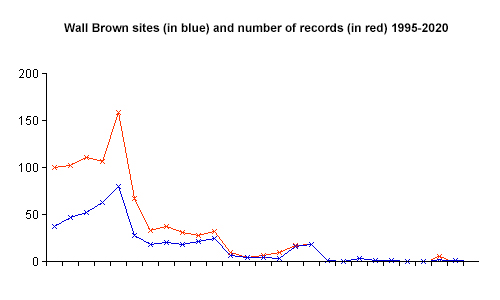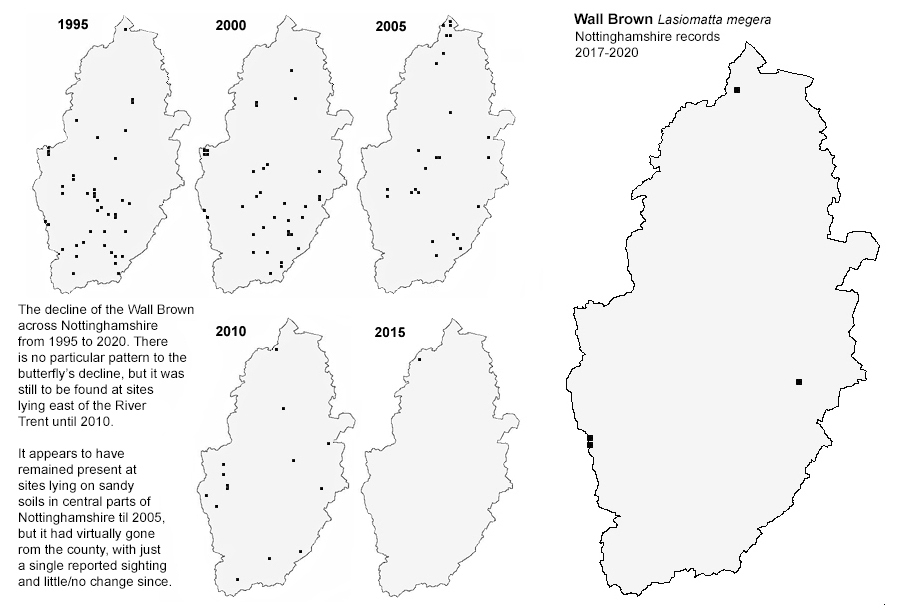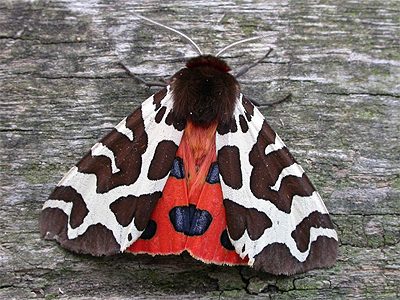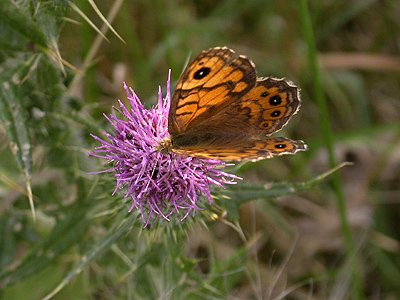

| Some recent Nottinghamshire records of the Wall Brown |
| .... |
| Of all
Nottinghamshire butterflies, the Wall Brown has probably had the most
troubling of histories since the middle of the 1990's and probably only
the Comma Polygonum c-album can lay claim to a similar title.
Now I'm aware that for some strange reason, known only to some expert who's locked away in some forgotten, dusty old office somewhere, the butterfly is now referred to as 'Wall'. I still far prefer the butterfly's former name of Wall Brown and I think most people feel the same. It's such a lovely species and Wall Brown is a less cold sounding name than 'Wall'. I say 'it is' a lovely species, but that really ought to be written in the past tense, as what was once a common and widespread species, has to all intents and purposes, disappeared from the county's record books. |
 |
|
| ... | ||
| The decline of a
common
butterfly
The Wall Brown's demise is nothing new, as Dilys and I covered its Nottinghamshire decline on eakringbirds.com a number of years ago, telling of just how this once familiar species had gone from being common and widespread (though never found in numbers anywhere) to more or less extinction as a Nottinghamshire butterfly. It's as drastic and as simple a tale as that, yet rarely does anyone seem to mention its demise. Perhaps that's just as worrying? And it's not just a local decline either, as the Wall Brown has suffered similarly in all our neighbouring counties and has largely retreated to coastal areas and more elevated areas. The butterfly recorder for Derbyshire Ken Orpe, has written on the Wall Brown's fortunes over in Derbyshire and much of what he relates mirrors to what has happened here in Nottinghamshire, with the butterfly showing a sudden steep decline to reach a low point in 2008. Distribution maps clearly show that in Derbyshire, the Wall Brown declined from lower elevated areas in the east of the county, but increased at sites of higher elevation where it favours rocky outcrops and ledges and where conditions seem to be more to the butterfly's liking. Ken states that after 2008, the Wall Brown increased year on year and it even started to reappear in some of its former haunts until 2020, when there was a sudden 25% decline in the butterfly's distribution and a near 50% drop in reported numbers of the butterfly. |
||
| ... | ||
| Total reported records and sites for the Wall Brown in Nottinghamshire between 1995 and 2020 | |||||||||||||||||||||||||||
| ............... | |||||||||||||||||||||||||||
| 1995 | 1996 | 1997 | 1998 | 1999 | 2000 | 2001 | 2002 | 2003 | 2004 | 2005 | 2006 | 2007 | 2008 | 2009 | 2010 | 2011 | 2012 | 2013 | 2014 | 2015 | 2016 | 2017 | 2018 | 2019 | 2020 | ||
| Records | 100 | 102 | 111 | 106 | 159 | 67 | 33 | 37 | 31 | 28 | 32 | 10 | 4 | 6 | 10 | 17 | 18 | 1 | 0 | 3 | 1 | 1 | 0 | 0 | 4 | 2 | |
| Sites | 37 | 47 | 52 | 63 | 80 | 28 | 18 | 20 | 18 | 21 | 25 | 6 | 4 | 4 | 3 | 16 | 18 | 1 | 0 | 3 | 1 | 1 | 0 | 0 | 2 | 1 | |
| ... |
|
Here in Nottinghamshire, following a sudden drop in both the number of records and sites being reported to the county recorder between 2006 and 2008, a short-lived increase occurred between 2009 and 2011, which coincides with Ken Orpe's Derbyshire data. But unlike what happened in Debyshire, there has been no such recovery here in Nottinghamshire, only a continuous 'flat-line' in county records since the butterfly declined for a second time in and more or less disappeared back in 2012. Worryingly, there seems to be no change in fortunes regarding the butterfly's current situation anywhere on the horizon. |
| ... |
 |
| ... |
|
Heard a similar tale before? If this tale reminds you of another species then it should do, as the Garden Tiger Arctia caja (Linaeus, 1758) suffered a similar change in fortunes some years before the Wall Brown. And if you're looking for a reason, then it must be through modern farming practices and the over-use of pesticidal or herbicidal chemicals, or (more likely) a climatic change that the butterfly just couldn't cope with. But if the latter were the case, then it might have been expected that the butterfly would retreat south, or move north. In a way though, I suppose it already has. |
| ... | ||
 |
Excessive rates of parasitism in the larval stage can certainly be ruled out, as most species (both butterflies and other invertebrates) suffer increased bouts of parasitism on a regular basis. Recounted elswhere on this website, is how Dilys and I noticed a roughly four-yearly cycle in the populations of some shieldbug and ladybird species and it obviously occurs in most insects. The most well known butterfly to suffer high rates of parasitism is the Holly Blue Celastrina argiolus (Linnaeus, 1758), which is highly parasitised every few years by the wasp Listrodomus nycthemerus (Gravenhorst, 1820). But gregariously-brooded butterflies such as the Nymphalids, are also affected by varying rates of parasitism annually. Not that many years ago, the conservation organisations, TV and the national Press, were painting a dire picture regarding the sudden decline in Small Tortoiseshell numbers across most of the UK and although Dilys and myself recorded a drop in the number of records during 2018 and 2019, numbers quickly bounced back in 2020 and 2021 to around double the number of records recorded before 2018. |
|
| ... | ||
| The publicity regarding the Small Tortoiseshell's apparent decline over
much of the UK, focussed on the arrival of the Tachinid fly Sturmia
bella (Meigen, 1824) to the UK in the late 1990's. Sturmia bella
is a parasitic Tachinid fly that uses Small Tortoiseshell larvae as
hosts. It was first recorded in Hampshire in 1998 and although it has
been recorded several times over the last couple of years from south Nottinghamshire, it has
not yet turned up anywhere north of Nottingham, although
is doubtless present. If the drop in Small Tortoiseshell numbers
occurs again, it may well be found to coincide with higher than normal
numbers of Sturmia bella, however, a cold and wet early Spring can
have a similar effect on Small Tortoiseshell numbers. So once again in relation to an insect's decline, we're back at climate change as being the preferred reason for the Wall Brown's Nottinghamshire decline, but national maps produced by Butterfly Conservation, show that those central UK counties with no coastline or higher elevated sites are now pretty much devoid of records. Its thought likely that the increase in weather extremes now, could be responsible for the Wall Brown's decline. When we wrote a review of Nottinghamshire butterflies back in 2017, we found a potential link to the decline of the Wall Brown with an increase in the number of extremely wet months with over 100mm of rain during the breeding season. The Wall Brown's three post-1995 peaks in 1999, 2005 and 2011, all came after several drier Summers. Post-2017 records That review of the county's butterflies detailed everything between 1995 and up to the end of 2017. So what has happened to the Wall Brown since then? It would have been nice to have related a degree of positivity, although maybe the more positive-minded reading this may be able to take some degree of hope from the last three years of data (to 2020) at hand. |
||
| ..... | ||
| The Wall Brown has continued to be
almost virtually absent from Nottinghamshire since 2017 and going back
to it's fatal crash - since 2011. Unlike in neighbouring Derbyshire,
there was no increase in records and sites after 2011 and the handful of
Nottinghamshire records there has been, certainly gives little hope or
indication of any comeback. Following a blank year for records in 2017, another occurred in 2018 and both these years followed just single county records in 2015 and 2016. 2019 saw four records from two sites, with a record from Farndon near Newark and records from Bennerley Marsh and Bennerley Viaduct, which I'd considered would be the one site but actually produces two 1km grid squares on the map. Interestingly, I can't find any post-1995 records from Farndon, so it's probably a first record there since before 1995. In 2020, there were just two county records. Both were from Misson in the north of Nottinghamshire. Now the occurrence at Misson could be very interesting, as this part of the Idle Valley has been one of the more regular areas for Wall Brown since 1995. With a record back in 1996, there were further records from the Misson area between 2003 and 2007, then again in 2012. |
 |
|
| ..... | ||
| Other Idle Valley sites also
produced records over that time, so maybe the butterfly is just about
maintaining a presence in the north Nottinghamshire carrlands, or maybe
these are just wanderers from neighbouring South Yorkshire? Wandering
individuals are likely in suitable years and that could apply to the
Bennerley records, who's records could have been part of the Derbyshire
range expansion. It's so sad that we've apparently lost what was once such a common 'everyday' butterfly, and one so regularly seen in our towns and cities too. There's a generation of young naturalists growing up now, who will have never seen a Nottinghamshire Wall Brown and who may never see one unless maybe something is done. It was never seen anywhere in numbers, almost always just in ones and twos, but I remember it being no surprise to see one right in the centre of Nottingham when I worked there. It was typically a butterfly of wasteground, railway tracks and sidings, rough unkempt areas, gardens, the sides of buildings and around walls of course. Whoever named it the Wall Brown wasn't daft, but whoever decided to remove the 'Brown' bit was. Perhaps we have tidied and cleansed everywhere too much, weed-killed our parks, gardens and streets to death? We've built on, or paved over those old small areas of rough ground, or untidy corners once favoured by the Wall Brown. Yet it strikes me that there is similarity between the artificial outcrops and ledges created by the buildings in our towns and cities, to the butterfly's now preferred upland outcrops and ledges. With the increase in 'green roofs' on top of many new developments, maybe there is some opportunity to reinstate the butterfly again. They do it with rarities, why not try with a once common one? |
||
| Butterflies |
| Homepage |